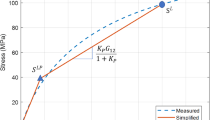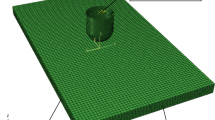Abstract
Aeronautic Certification rules established for the metallic materials are not convenient for the composite structures concerning the resistance against impact. The computer-based design is a new methodology that is thought about to replace the experimental tests. It becomes necessary for numerical methods to be robust and predictive for impact. Three questions are addressed in this study: (i) can a numerical model be “mechanically intrinsic” to predict damage after impact, (ii) can this model be the same for a lab sample and a large structure, and (iii) can the numerical model be predictive enough to predict the Compression After Impact (CAI)? Three different computational strategies are used and compared: a Cohesive Model (CM), a Continuous Damage Model (CDM) coupling failure modes and damage, and a Mixed Methodology (MM) using the CDM for delamination initiation and the CM for cracks propagation. The first attempts to use the Smooth Particle Hydrodynamics method are presented. Finally, impact on a fuselage is modelled and a numerical two-stage strategy is developed to predict the CAI.























Similar content being viewed by others
References
Abrate, S.: Impact on composite structures. Cambridge University Press, (1998)
Richardson, M.O.W., Wisheart, M.J.Y.: Review of low-velocity impact properties of composite materials. Compos A 27A, 1123–1131 (1996)
Reifsnider, K.L., Case, S.W.: Damage tolerance & durability in material systems. Wiley-Intersciences, ISBN-10 0471152994 (2002)
Shi, Y., Pinna, C., Soutis, C.: Modelling impact damage in composite laminates: a simulation of intra- and inter-laminar cracking. Compos Struct 114(Aug), 10–19 (2014)
Mi, Y., Crisfield, M., Davies, G., Hellweg, H.: Progressive delamination using interface elements. J Compos Mater 32, 1246–1272 (1998)
Alfano, G., Crisfield, M.: Finite element interface models for the delamination analysis of laminated composites: mechanical and computational issues. Int J Numer Methods Eng 77(2), 111–70 (2001)
Reedy Jr., E.D., Mello, F.J., Guess, T.R.: Modeling the initiation and growth of delaminations in composite structures. J Compos Mater 31(8), 812–831 (1997)
Windisch, M., Sun, D.-Z., Memhard, D., Siegele, D.: Defect tolerance assessment of Ariane 5 structures on the basis of damage mechanics material modelling. Eng Fract Mech 76, 59–73 (2009)
Bertolini, J., Castanié, B., Barrau, J.J., Navarro, J.P.: Multi-level analysis of skin/stringer debonding. ICCM17, Edimburgh, 27–31 July, United Kingdom, (2009)
Chen, C., Espinosa, C., Michel, L., Lachaud, F.: A numerical approach for analysing post-impact behaviour of composite laminate under in-plane compression. ECCM 15, Venice, 24–28 June, Italy, (2012)
Prombut, P., Michel, L., Lachaud, F., Barrau, J.J.: Delamination of multidirectional composite laminates at 0°/θ° ply interfaces. Eng Fract Mech 73(16), 11 (2006)
Tay, T.E.: Characterization and analysis of delamination fracture in composites, an overview of developments from 1990 to 2001. Appl Mech Rev 56(1), 1–32 (2001)
Lachaud, F.: Contribution à l’analyse multi échelle du comportement non linéaire matériau des structures composites. Habilitation à Diriger des Recherches, Université de Toulouse. France. http://oatao.univ-toulouse.fr/5165/. (2011)
Ilyas M.: Damage modelling of carbon epoxy laminated composites submitted to impact laoding. PhD thesis, Université de Toulouse, ISAE, France, (2010)
Bouvet, C., Castanie, B., Bizeul, M., Barrau, J.J.: Low velocity impact modeling in laminate composite panels with discrete interface elements. Int J Solids Struct 46, 2809–2821 (2009)
Lachaud, F., Espinosa, C., Michel, L., Rahme, P., Piquet, R.: Modelling strategies for simulating delamination and matrix cracking in composites laminates. Appl Compos Mater (2014). doi:10.1007/s10443-014-9413-4
Shi, Y., Pinna, C., Soutis, C.: Interface cohesive elements to model matrix crack evolution in composite laminates. Appl Compos Mater 21, 57–70 (2014)
Ilyas, M., Limido, J., Lachaud, F., Espinosa, C., Salaun, M.: Modélisation SPH 3D de l’impact basse vitesse sur plaque composite. 19ème Congrès Français de Mécanique, Marseille. France, (2009)
Ilyas, M., Espinosa, Ch., Lachaud, F., Salaün, M.: Dynamic delamination using cohesive finite elements. 9th International DYMAT conference, 7–11 September, Brussels, Belgium, (2009)
Guinard, S., Allix, O., Guédra-Degeorges, D., Vinet, A.: A 3D damage analysis of low-velocity impacts on laminated composites. Compos Sci Technol 62, 585–589 (2002)
Aboissière, J.: Propagation de dommages d’impact dans un matériau composite stratifié à fibres de carbone et résine époxyde. PhD Dissertation, Université de Toulouse, France, (2003)
Guédra-Degeorges, D.: Recent advances to assess mono- and multi-delamaminations behaviour of aerospace composites. Compos Sci Technol 66, 796–806 (2006)
Suemasu, H., Sasaki, W., Ishikawa, T., Aoki, Y.: A numerical study on compression behavior of composites plates with multiple circular delaminations considering delamination propagation. Compos Sci Technol 68, 2562–2567 (2008)
Craven, R., Iannucci, L., Olsson, R.: Delamination buckling: a finite element study with realistic delamination shapes, multiple delaminations and fibre fracture cracks. Compos A: Appl Sci Manuf 41(5), 684–692 (2010)
Liu, G. R., Liu, M. B.: Smoothed particle hydrodynamics—a Meshfree particle method. World Scientific Publishing Co, (2003)
Silvestrov, V.V., Plastinin, A.V., Gorshkov, N.N.: Hypervelocity impact on laminate composite panels. Int J Impact Eng 17, 751–762 (1995)
Acknowledgments
The authors are grateful of Higher Education Commission of Pakistan for partial funding. Special thanks are also extended to IMPETUS Afea France and all the students and technical staff of ISAE for their valuable input towards numerical and experimental aspects, respectively.
Author information
Authors and Affiliations
Corresponding author
Appendix A
Appendix A
Rights and permissions
About this article
Cite this article
Lachaud, F., Espinosa, C., Michel, L. et al. Modelling Strategies for Predicting the Residual Strength of Impacted Composite Aircraft Fuselages. Appl Compos Mater 22, 599–621 (2015). https://doi.org/10.1007/s10443-014-9427-y
Received:
Accepted:
Published:
Issue Date:
DOI: https://doi.org/10.1007/s10443-014-9427-y












